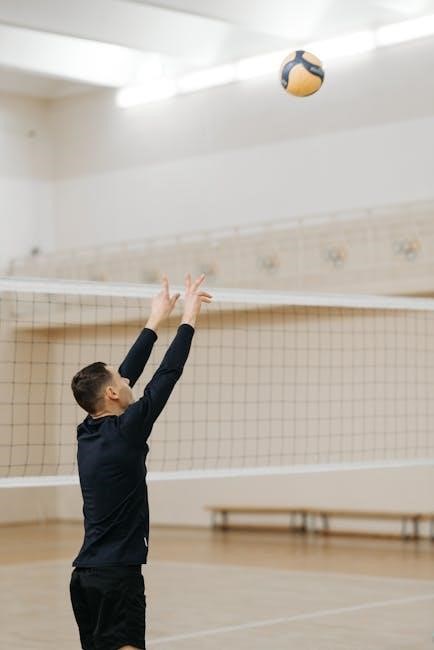The Vanderbilt Baseball Long Toss Program is designed to enhance arm strength, conditioning, and mechanical consistency through structured throwing phases, recognized for its proven results in baseball.
1.1 Overview of the Program’s Purpose and Benefits
The Vanderbilt Baseball Long Toss Program is specifically designed to improve arm strength, mechanical consistency, and overall throwing endurance. Its primary purpose is to condition pitchers’ arms for the demands of the preseason while minimizing injury risks. By focusing on progressive throwing phases, the program ensures gradual development, allowing athletes to build resilience and maintain performance longevity. The structured approach emphasizes proper mechanics and recovery, making it a comprehensive tool for both pitchers and position players. The program’s benefits include enhanced arm durability, better control, and a stronger foundation for in-game performance, making it a cornerstone of Vanderbilt’s baseball training methodology.
1.2 Historical Context and Development of the Program
The Vanderbilt Baseball Long Toss Program was developed by the university’s coaching staff and sports performance team to address the unique demands of college baseball. Drawing from proven long toss methodologies, the program combines traditional throwing techniques with modern sports science. Initially designed as an off-season conditioning tool, it has evolved to include dynamic phases that build arm strength, endurance, and consistency. Influenced by approaches like Driveline Baseball and Alan Jaeger’s long toss method, Vanderbilt’s program emphasizes progressive overload and individual adaptation. Over time, it has become a cornerstone of their player development strategy, contributing to the success of their pitching staff.

Key Components of the Vanderbilt Long Toss Program
The program includes systematic phases like stretching out, pull down, and surgical tubing exercises, designed to build arm strength, improve mechanics, and ensure safe progression.
2.1 The Stretching Out Phase
The Stretching Out Phase is the foundational component of the Vanderbilt Long Toss Program, designed to gradually increase throwing distance while emphasizing arm health and mechanical consistency. Players begin with shorter throws and progressively extend the range, focusing on low effort and high repetition to build endurance. This phase prioritizes arm care, ensuring athletes avoid early strain and develop a strong foundation for more intense training. By starting with controlled, methodical progression, the Stretching Out Phase sets the stage for advanced throwing mechanics and prepares the arm for the demands of the Pull Down Phase and other program elements.
2.2 The Pull Down Phase
The Pull Down Phase follows the Stretching Out Phase, focusing on transitioning from extended distances back to shorter, more intense throws. This phase emphasizes improving throwing mechanics, arm speed, and accuracy while maintaining the strength and endurance built in the previous phase. Players gradually reduce their throwing distance, concentrating on precise, high-effort throws to refine their delivery and consistency. The Pull Down Phase is critical for translating the gains from long toss into functional baseball skills, preparing athletes for the demands of live game situations and mound work. It bridges the gap between conditioning and performance, ensuring readiness for competitive play.
2.3 Integration of Surgical Tubing Exercises
Surgical tubing exercises are a cornerstone of the Vanderbilt Baseball Long Toss Program, serving as a critical component for arm care and strength development. These exercises target the shoulder and arm muscles, focusing on resistance-based movements to build durability and endurance. Tubing work is often performed during the initial phases of the program, complementing the Stretching Out and Pull Down Phases. By incorporating low-impact, high-repetition exercises, players can strengthen their throwing muscles without overexertion. This method is particularly effective for injury prevention and recovery, making it a vital element of the program’s structure. Surgical tubing exercises ensure athletes build a strong foundation for long toss and mound work.
Benefits of the Long Toss Program
The program enhances arm strength, improves mechanical consistency, aids in recovery, and prevents injuries, while preparing pitchers for the demands of the preseason effectively.
3.1 Increased Arm Strength and Durability
The Vanderbilt Baseball Long Toss Program significantly improves arm strength and durability through progressive throwing phases. By starting with shorter distances and gradually increasing, pitchers build resilience and power. The structured approach, including Surgical Tubing exercises, enhances muscular endurance while minimizing injury risk. Players develop the ability to maintain velocity and consistency over extended periods, ensuring long-term durability. The program’s focus on mechanical efficiency and gradual overload ensures sustainable strength gains, preparing arms for the rigors of competition. This phased progression is key to achieving peak arm strength while maintaining health throughout the season.
3.2 Improved Mechanical Consistency
The Vanderbilt Baseball Long Toss Program emphasizes proper throwing mechanics to ensure consistency and reduce injury risk. By focusing on a structured progression, pitchers develop a repeatable delivery, enhancing accuracy and control. The program’s phases, such as the Stretching Out and Pull Down phases, help athletes refine their throwing patterns, promoting efficient energy transfer and consistent release points. Over time, this repetitive process builds muscle memory, leading to more reliable performance on the mound. Improved mechanical consistency not only boosts effectiveness but also reduces the strain on the arm, making it a cornerstone of the program’s success. This focus on fundamentals is key to long-term development.
3.3 Enhanced Recovery and Injury Prevention
The Vanderbilt Long Toss Program prioritizes arm health through structured recovery protocols and injury prevention strategies. By incorporating surgical tubing exercises and gradual progression, pitchers condition their arms to withstand the demands of throwing. The program emphasizes listening to your arm, ensuring adequate rest periods to avoid overexertion. Proper warm-up and cool-down routines, along with dynamic stretching, further reduce injury risk. The focus on mechanical consistency also minimizes stress on the arm, promoting long-term durability. These elements collectively create a holistic approach to maintaining arm health, making the program a valuable tool for preventing injuries and enhancing recovery in baseball players. This proactive method ensures sustained performance.
3.4 Better Preparation for the Preseason
The Vanderbilt Long Toss Program is specifically designed to prepare pitchers for the demands of the preseason. By focusing on gradual progression and arm conditioning, the program ensures that athletes build a strong foundation of arm strength and endurance. The structured phases of the program, including the Stretching Out and Pull Down phases, help pitchers transition smoothly from the off-season to preseason training. This systematic approach reduces the risk of overexertion while enhancing mechanical consistency. As a result, pitchers enter the preseason with improved arm health, better velocity, and increased confidence, setting them up for success in competitive scenarios. This preparation is key to peak performance.
Structure and Duration of the Program
The program typically lasts 4-6 weeks, divided into distinct phases, each spanning 10-14 days. It is adaptable to individual recovery rates and needs.
4.1 Off-Season Timeframe (4-6 Weeks)
The Vanderbilt Baseball Long Toss Program is structured to last 4-6 weeks during the off-season, focusing on arm care and progressive throwing exercises. This period ensures players build a strong foundation for the preseason, with phases designed to enhance strength, mechanics, and recovery. The program avoids mound work during this timeframe, emphasizing long toss and surgical tubing exercises to promote arm health and durability. This structured approach allows players to gradually increase intensity, ensuring they are well-prepared for the demands of the upcoming season while minimizing injury risks. The 4-6 week window is a critical period for growth and conditioning.
4.2 Phases of Progression (10-14 Days Each)
The Vanderbilt Baseball Long Toss Program is divided into distinct phases, each lasting 10-14 days, to ensure progressive overload and adaptation. The initial phase focuses on foundational arm care and stretching exercises, while subsequent phases introduce longer throws and mechanical adjustments. Each phase builds on the previous one, allowing players to gradually increase intensity and distance. This structured progression minimizes the risk of overloading the arm too quickly, promoting injury prevention and consistent improvement. The program’s phased approach ensures players are adequately prepared for the demands of the next stage, fostering both strength and mechanical efficiency over time.
4.3 Adaptability Based on Individual Needs
The Vanderbilt Baseball Long Toss Program emphasizes adaptability to accommodate individual player needs, ensuring optimal progress and safety. Coaches closely monitor each athlete’s arm health, mechanics, and recovery, making adjustments as necessary. Players with prior injuries or mechanical inefficiencies may follow modified protocols, such as reduced throwing distances or additional recovery days. The program’s flexibility allows for personalized progression, preventing overtraining and fostering long-term durability. This tailored approach ensures that every player, regardless of experience or ability, can benefit from the program while minimizing the risk of injury. Adaptability is key to achieving the program’s goals of strength, consistency, and peak performance.
Specific Exercises and Drills
The program includes dynamic warm-ups, long toss drills at varying distances, compression toss for accuracy, and J-Bands for resistance training to build strength and improve mechanics.
5.1 Dynamic Warm-Up Routine
The dynamic warm-up routine in the Vanderbilt Baseball Long Toss Program is a comprehensive series of movements designed to prepare the body for throwing. It includes arm circles, leg swings, and torso twists to enhance flexibility and coordination; The routine progresses from slow, controlled movements to more dynamic exercises, ensuring optimal blood flow and muscle activation. This sequence is crucial for preventing injuries and improving range of motion. By incorporating these exercises, players build a foundation for effective long toss training, reducing the risk of strain and enhancing overall performance.
5.2 Long Toss Drills at Varying Distances
The Vanderbilt Baseball Long Toss Program incorporates drills at varying distances to progressively challenge players. Starting at shorter distances (60-90 feet), players focus on accuracy and control before gradually increasing the range to 120-250 feet. These drills emphasize proper mechanics and arm strength while building consistency. The progression ensures players adapt to the demands of throwing at different lengths, enhancing both endurance and precision. Varying distances also help players develop the ability to throw with intent and accuracy, preparing them for game situations. This structured approach is tailored to individual development, ensuring a balanced focus on strength, mechanics, and performance.
5.3 Compression Long Toss for Accuracy
Compression Long Toss for Accuracy is a drill designed to refine throwing mechanics and precision. Players throw at shorter distances (90-120 feet) with maximum effort, focusing on putting the ball on a line. This exercise emphasizes consistency, accuracy, and proper arm mechanics. By limiting the distance, players can better control their throws, translating to improved performance in game situations. The drill also helps build arm strength and velocity while maintaining precision. Coaches often incorporate this drill to address mechanical flaws and enhance overall throwing consistency, making it a key component of the Vanderbilt program’s structure and progression.
5.4 J-Bands and Resistance Training
J-Bands and resistance training are integral to the Vanderbilt Baseball Long Toss Program, focusing on arm strength, speed, and endurance. These lightweight resistance bands are used for high-repetition exercises, typically involving 14 reps per set, to target the shoulder, elbow, and forearm muscles. The bands provide consistent resistance throughout the throwing motion, helping pitchers develop arm speed and control. Used in both off-season and in-season training, J-Bands complement the long toss drills by enhancing arm durability and recovery. This training method is particularly effective for improving velocity and maintaining proper mechanics, making it a cornerstone of the program’s arm care and strength-building approach.

Recovery and Maintenance
Recovery and maintenance are crucial for arm health, emphasizing proper cool-down routines, nutrition, and sleep to optimize performance and prevent injury in the long toss program.
6.1 Importance of Listening to Your Arm
Listening to your arm is foundational to the Vanderbilt Baseball Long Toss Program, ensuring players avoid overexertion and prevent injuries. The program emphasizes resting when discomfort arises, as pushing through pain can lead to long-term damage. Proper recovery and maintenance are prioritized to sustain arm health and performance. Ignoring early warning signs can result in decreased velocity, accuracy, or even season-ending injuries. By adhering to this principle, athletes maintain optimal arm function and durability, fostering consistent performance throughout the season. The program encourages a mindset of awareness and responsibility, ensuring each player progresses safely and effectively.
6.2 Cool-Down and Stretching Routines
A proper cool-down and stretching routine are essential components of the Vanderbilt Baseball Long Toss Program, aiding in recovery and injury prevention. These exercises focus on reducing muscle tension and improving flexibility, particularly in the shoulders, elbows, and lower back. Dynamic stretches and light cardio are often incorporated to gradually lower heart rates and promote blood flow. The program emphasizes the importance of a structured post-throwing routine to maintain arm health and overall physical consistency. By dedicating time to these practices, players can enhance their resilience and ensure optimal performance during training and competition.
6.3 Nutrition and Sleep Recommendations
Nutrition and sleep play a critical role in optimizing recovery and performance within the Vanderbilt Baseball Long Toss Program. A balanced diet rich in lean proteins, complex carbohydrates, and healthy fats is essential for muscle repair and energy replenishment. Proper hydration is also emphasized to maintain arm health and overall bodily function. Additionally, prioritizing 7-9 hours of quality sleep per night is crucial for physical recovery and mental sharpness. The program encourages players to tailor their nutrition and sleep routines to their individual needs, ensuring they are adequately fueled and rested to maximize the benefits of the long toss regimen.

Comparison with Other Long Toss Programs

The Vanderbilt program differs from others like Driveline Baseball and Alan Jaeger’s method by emphasizing structured progression and individual adaptation, focusing on mechanical consistency and injury prevention.

7.1 Driveline Baseball Approach
The Driveline Baseball approach, popularized by Kyle Boddy, focuses on data-driven training and extreme long toss to build velocity and strength. Unlike Vanderbilt’s structured progression, Driveline emphasizes individualization and technology, incorporating tools like radar guns and biomechanical analysis. Proponents such as Trevor Bauer and Dylan Bundy highlight its effectiveness in developing elite throwers. Driveline’s program often includes high-intensity, long-distance throws to maximize arm speed and durability. While both programs aim to enhance performance, Driveline’s method leans heavily on innovation and personalized feedback, distinguishing it from Vanderbilt’s more traditional, mechanically focused approach. Each program caters to different training philosophies and athlete needs.
7.2 Alan Jaeger’s Long Toss Method
Alan Jaeger’s long toss method emphasizes a more natural, progressive approach to building arm strength and endurance. Unlike Vanderbilt’s structured phases, Jaeger’s program focuses on individualized training, encouraging players to listen to their bodies and gradually increase throwing distance. His method incorporates weighted balls and dynamic warm-ups to improve mechanical consistency and reduce injury risk. Jaeger’s approach prioritizes arm health and organic development over aggressive distance throwing, making it a popular choice for players seeking a balanced, sustainable training regimen. This philosophy aligns with Vanderbilt’s emphasis on recovery and mechanical consistency but offers a more flexible, adaptive framework for athletes.
7.4 MLB Players’ Experiences (Trevor Bauer, Dylan Bundy)
Trevor Bauer and Dylan Bundy, both MLB standouts, have been vocal advocates of long toss training. Bauer, known for his intense work ethic, incorporated extreme long toss into his regimen, often throwing up to 400 feet to build arm strength and durability. Similarly, Bundy adopted a progressive long toss program early in his career, emphasizing mechanical consistency and injury prevention. Their experiences highlight the practical application of long toss principles, blending traditional methods with modern adaptations. Both pitchers credit long toss for enhancing their performance and longevity, aligning with the Vanderbilt program’s focus on arm health and sustainable development.
Scientific Research and Studies
Scientific studies validate the Vanderbilt program’s effectiveness, focusing on arm strength, durability, and injury prevention through biomechanical analysis and research-backed training methods, providing a foundation for optimal performance and reduced injury risk.
8.1 Studies on Arm Strength and Long Toss

Research highlights the Vanderbilt program’s impact on arm strength, with studies showing significant improvements in velocity and endurance. Biomechanical analyses reveal how long toss enhances mechanical efficiency, reducing strain. Data from sports medicine journals indicate that structured throwing phases, like the Stretching Out and Pull Down phases, contribute to increased arm durability. These findings are supported by MLB players’ experiences, such as Trevor Bauer and Dylan Bundy, who credit long toss for their performance gains. The program’s emphasis on progressive overload and individual adaptation aligns with scientific recommendations for optimal arm development and injury prevention.
8.2 Research on Injury Prevention
Studies emphasize the Vanderbilt program’s role in injury prevention through structured progression and recovery-focused practices. Research indicates that long toss, when implemented correctly, reduces the risk of overuse injuries by promoting arm durability and mechanical consistency. The program’s emphasis on listening to the arm and incorporating recovery phases aligns with findings that stress the importance of rest and gradual workload increases. Surgical tubing exercises and dynamic warm-ups further contribute to injury prevention by enhancing flexibility and strength. These methods are supported by studies on pitcher health, highlighting the program’s effectiveness in safeguarding athletes while improving performance.
8.3 Biomechanical Analysis of Throwing Mechanics
Biomechanical studies highlight the Vanderbilt program’s focus on optimizing throwing mechanics to enhance performance and reduce injury risk. The program’s structured phases, such as the Stretching Out and Pull Down phases, are designed to improve arm efficiency and maintain proper form. Research shows that consistent long toss drills promote a balanced delivery, reducing strain on the shoulder and elbow. Surgical tubing exercises further support this by strengthening stabilizing muscles. These methods align with biomechanical principles that emphasize proper sequencing and timing in the throwing motion, contributing to both performance enhancement and injury prevention for pitchers and position players alike.

Practical Application and Coaching Tips

Coaches should emphasize proper technique, gradual progression, and individualized adjustments, ensuring players adapt effectively to the program’s demands while maintaining a focus on injury prevention and performance.
9.1 How to Implement the Program
Implementation begins with a thorough assessment of each player’s current arm strength and mechanics. Coaches should introduce the program gradually, starting with the Stretching Out Phase, ensuring proper warm-up routines and surgical tubing exercises. Emphasize the importance of listening to the arm and avoiding overexertion. Progress players through defined phases, incorporating dynamic warm-ups and long-toss drills at varying distances. Monitor adherence to the structured 4-6 week off-season timeline, adjusting based on individual recovery and performance. Coaches should provide consistent feedback and ensure players understand the purpose of each phase to maximize effectiveness and safety throughout the program.
9.2 Modifying the Program for Individual Needs
Modifying the Vanderbilt Baseball Long Toss Program involves tailoring exercises based on individual player needs, recovery rates, and performance. Coaches should assess each player’s progress and adjust phase durations or intensity as needed. For example, players with limited arm strength may start with shorter distances or incorporate more surgical tubing exercises. Conversely, advanced players can progress to longer toss distances sooner. Incorporating J-Bands or varying long toss drills can also be customized to address specific mechanical issues. Communication between players and coaches is key to ensuring modifications align with individual goals while maintaining the program’s core principles of safety and effectiveness.
9.3 Monitoring Progress and Adjustments
Regularly monitoring progress is essential to ensure the Vanderbilt Long Toss Program’s effectiveness. Coaches should track players’ throwing distances, velocity, and mechanical consistency during each phase. Adjustments are made based on individual recovery rates and performance feedback. For instance, players showing rapid progress can advance to longer toss distances, while others may need additional time in earlier phases. Incorporating tools like J-Bands or compression drills can help address specific needs. Coaches should also observe arm health and mechanics, making modifications to prevent overuse injuries. Documentation of progress and open communication between players and coaches ensures the program remains tailored to individual development and goals;
The Vanderbilt Baseball Long Toss Program is a proven, structured approach to enhancing arm strength, durability, and consistency, with scientifically-backed methods for optimal player development and injury prevention.
10.1 Summary of Key Points
The Vanderbilt Baseball Long Toss Program is a scientifically-backed, structured approach to improving arm strength, durability, and consistency. It incorporates phases like the Stretching Out and Pull Down phases, along with surgical tubing exercises, to enhance throwing mechanics. The program emphasizes injury prevention, recovery, and preseason preparation, with adaptability based on individual player needs. By focusing on progressive overload and mechanical consistency, it helps pitchers build resilience and maintain peak performance throughout the season. Its proven effectiveness has made it a cornerstone of modern baseball training, supported by research and real-world results from top players and coaches.
10.2 Final Thoughts on the Program’s Effectiveness
The Vanderbilt Baseball Long Toss Program is widely regarded as one of the most effective training systems for enhancing arm strength, consistency, and durability. Its structured phases, combined with a focus on recovery and mechanical efficiency, have proven to elevate pitchers’ performance while reducing injury risks. The program’s adaptability to individual needs ensures it remains a versatile tool for players at all levels. By blending scientific research with practical application, it has become a benchmark for modern baseball training, delivering measurable results and long-term benefits for athletes aiming to excel in the sport.